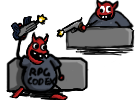Momock
Augur
- Joined
- Sep 26, 2014
- Messages
- 645
That's what you get for going with "rigid blocks that physically block the path" model.One disadvantage of grid less TB is that it's less obvious what is blocking moves and what is not (Can I squeeze past these two obstacles / mobs / characters - will my tank block this doorway?).
It's better to assume that solid core of your character is surrounded by non-solid halo of their reach, which doesn't prevent friendly movement or own movement by obstacles, but is used for actual blocking. Then you can block passages by overlapping weapon ranges with obstacles and each other, without any need for being pixel exact.
Of course with gridless you do need some extra UI aids:
Otoh you get to move and reposition arbitrarily and have a lot of subtle mechanics involving reach and movement.
- Ability to queue any reasonable sequence of moves not limited to current turn (to make sure that your brilliant plan doesn't require you to go a pixel further than you actually can) - reasonable means just short of "fuck, if we do that we'll run out of RAM"
- Relevant ranges and passabilities overlaid (possibly on demand) on both current and planned/expected tactical situations
- Unambiguous presentation when movement crosses into range or hazard, and when ranges and hazards directly cross into obstacles.
OR
You can put a fucking grid so a can play the game instead of trying to understand all that indigest extradiegetic bullshit on the screen.




















